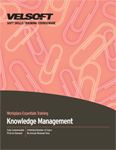Course outline for
Knowledge Management
Knowledge Management Course Outline

How to Use This Guide
Session One: Course Overview
Session Two: Definitions
What is Knowledge?
Communicating Explicit and Tacit Knowledge
What is Knowledge Management?
History of Knowledge Management
Session Three: The Business Case for Knowledge Management
Reducing Costs and Growing Sales with Knowledge Management
Personal Work Performance and Bottom Line Benefits
Business Case Basics
Sample Knowledge Management Business Case
Session Four: The Knowledge Management Mix
People
Recognition within the Knowledge Management Mix
Technology
Process
Session Five: The Knowledge Management Framework
Introduction
Needs Analysis
Resource Identification
Process Analysis, Identification, and Construction
Accumulating, Sharing, and Storing Knowledge
Session Six: ITandD’s Conundrum
Session Seven: Knowledge Management Models
The KM Process Framework (Bukowitz and Williams)
Knowledge Management Matrix (Gamble and Blackwell)
Process Model (Botha)
Knowledge Spiral Model (Nonaka and Takeuchi)
Session Eight: The Knowledge Management Toolkit
Cross-Functional Teams
Mentoring
Organizational Culture
IT Solutions
Which Technologies Would Be Best?
Session Nine: Implementing Knowledge Management Initiatives
Building Knowledge Networks
Creating a Knowledge Management Body of Knowledge (KMBOK)
Creating a Chief Knowledge Officer (CKO) Position
Advertise for Your CKO
Creating a Post-Mortem Plan
Creating Measures
Start With a Pilot
Where Do I Put This?
Support Your Organization Through the Change
Recommended Reading List
Post-Course Assessment
Pre- and Post-Assessment Answer Keys
Personal Action Plan
Download this course as a demo
Complete the form below and we'll email you an evaluation copy of this course:
Video
More Course Outlines in this Series
- Balanced Scorecard Basics
- Bullying in the Workplace
- Crisis Management
- Disability Awareness - Working with People with Disabilities
- Self-Management and Productivity
- The Importance of Peer-to-Peer Recognition
- Employee Accountability
- Lean Process Improvement
- Safety in the Workplace
- Preventing and Responding to Workplace Violence
- Knowledge Management
- Workplace Wellness
- Process Improvement with Gap Analysis
- Developing a High Reliability Organization
- Encouraging Sustainability and Social Responsibility in Business
- Purchasing and Procurement Basics
- Continuous Improvement with Lean
- Environmental Sustainability
- An Environmental Audit Primer
- Creating a Positive Work Environment
- Creating Successful Staff Retreats
- Six Sigma: Entering the Dojo
- Code of Conduct: Setting the Tone for Your Workplace
- Digital Citizenship
- Being a Team Player
- GDPR Readiness: Creating a Data Privacy Plan
- Collaboration
- Planning for Workplace Safety
- Developing a Safety Procedures Manual
- Beyond Workplace Politics
- GDRP Readiness: Getting The Message Out
- English As A Second Language
- Digital Transformation
- Mobbing in the Workplace
- Cybersecurity 1: Fundamentals for Employees
- Respect in the Workplace
- Psychological Health and Safety
- Workplace Ergonomics - Injury Prevention Through Ergonomics
- Business Ethics for the Office
- Leveraging Neurodiversity at Work
- Human-Centered Leadership
- Business Process Management
- Consent and Boundaries in the Workplace
- Strategic Planning
